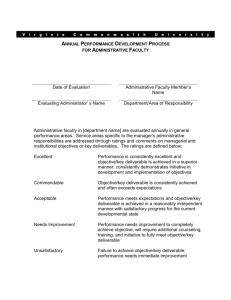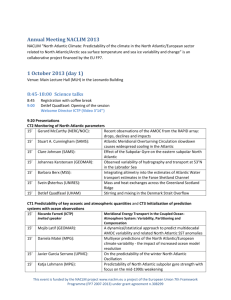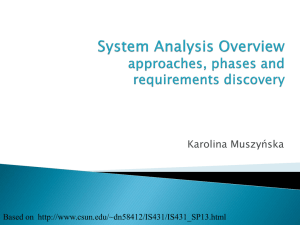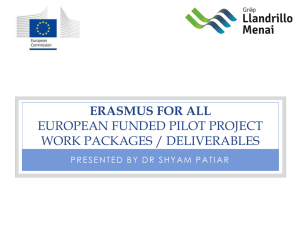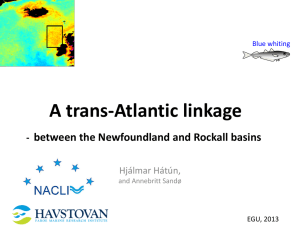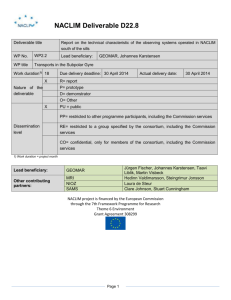D 22.14 - Naclim
advertisement
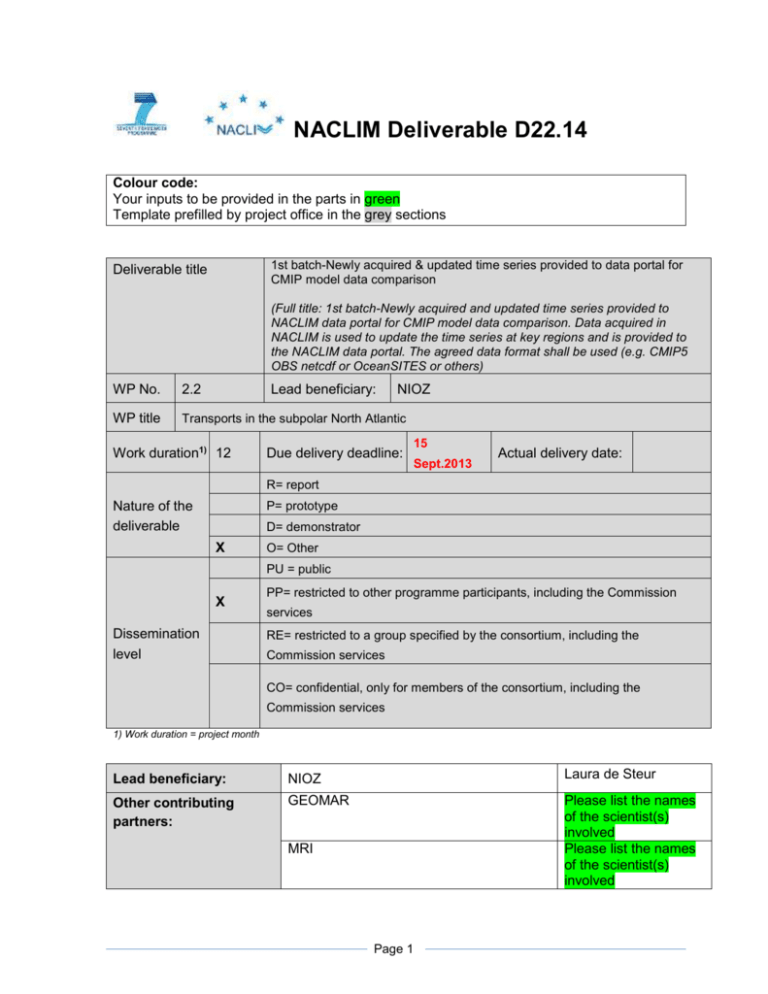
NACLIM Deliverable D22.14
Colour code:
Your inputs to be provided in the parts in green
Template prefilled by project office in the grey sections
1st batch-Newly acquired & updated time series provided to data portal for
CMIP model data comparison
Deliverable title
(Full title: 1st batch-Newly acquired and updated time series provided to
NACLIM data portal for CMIP model data comparison. Data acquired in
NACLIM is used to update the time series at key regions and is provided to
the NACLIM data portal. The agreed data format shall be used (e.g. CMIP5
OBS netcdf or OceanSITES or others)
WP No.
2.2
Lead beneficiary:
WP title
Transports in the subpolar North Atlantic
Work duration1) 12
NIOZ
Due delivery deadline:
15
Sept.2013
Actual delivery date:
R= report
Nature of the
deliverable
P= prototype
D= demonstrator
X
O= Other
PU = public
X
Dissemination
level
PP= restricted to other programme participants, including the Commission
services
RE= restricted to a group specified by the consortium, including the
Commission services
CO= confidential, only for members of the consortium, including the
Commission services
1) Work duration = project month
Lead beneficiary:
NIOZ
Laura de Steur
Other contributing
partners:
GEOMAR
Please list the names
of the scientist(s)
involved
Please list the names
of the scientist(s)
involved
MRI
Page 1
SAMS
Please list the names
of the scientist(s)
involved
Please list the names
of the scientist(s)
involved
Please list the names
of the scientist(s)
involved
Page 2
Index
1. Executive summary ........................................................................................................... 4
2. Project objectives .............................................................................................................. 4
3. Detailed report on the deliverable ...................................................................................... 4
4. References ........................................................................................................................ 5
5. List of publications ............................................................................................................. 5
6. The delivery is delayed: Yes No ............................................................................. 6
7. Changes made and difficulties encountered, if any............................................................ 7
8. Efforts for this deliverable .................................................................................................. 7
9. Sustainability ..................................................................................................................... 7
Page 3
1. Executive summary
Please provide in 1 page:
-
a brief summary of the work performed in this deliverable
-
a list of the main results achieved
Input requested here.
2. Project objectives
With this deliverable, the project has contributed to the achievement of the following objectives
(see DOW Section B.1.1):
Please put an X where appropriate
Nr.
1.
Objective
Assessing the predictability and quantifying the uncertainty in
forecasts of the North Atlantic/Arctic Ocean surface state
2. Assessing the atmospheric predictability related to the North
Atlantic/Arctic Ocean surface state
3. Monitoring of volume, heat and fresh water transports across key
sections in the North Atlantic
4. Quantifying the benefit of the different ocean observing system
components for the initialization of decadal climate predictions
5. Establishing the impact of an Arctic initialization on the forecast
skill in the North Atlantic/European sector
6. Quantifying the impact of predicted North Atlantic upper ocean
state changes on the oceanic ecosystem
7. Quantifying the impact of predicted North Atlantic upper ocean
state changes on socioeconomic systems in European urban
societies
8. Providing recommendations for observational and prediction
systems
9. Providing recommendations for predictions of the oceanic
ecosystem
10. Disseminating the key results to the climate service community
and relevant endusers/stakeholders
11. Constructing a dataset for sea surface and sea ice surface
temperatures in the Arctic
3. Detailed report on the deliverable
Please write a detailed report on the work done.
Input requested
Page 4
Yes
No
X
X
X
X
X
X
X
X
X
X
X
4. References
Please quote references here for this deliverable
Author, (year), “Title”, doi:
Input requested
5. Dissemination and uptake
5.1 Dissemination
Add the publications related to this deliverable. Please fill in the table below in ALL its parts.
These are inputs we must upload in the European Commission database SESAM.
Peer reviewed articles:
Title
Main author
All authors
Example
Systematic
Estimates of
Initial-Value
Decadal
Predictability
for Six
AOGCMs
Branstator,
G., H. Teng,
G.A. Meehl,
M. Kimoto,
J.R. Knight,
M. Latif, and
A. Rosati
Title of
the
periodica
l or the
series
JOURNA
L OF
CLIMAT
E
Number,
date or
frequency
Publisher
VOLUME
25
America
n
Meteorol
ogical
Society
Place of
publicat
ion
Check the NACLIM „Dissemination Plan“ on the open access requirements:
http://naclim.zmaw.de/Deliverables.2224.0.html
1
Page 5
Year of
publication
Permanent
identifiers[1]
DOI
2012
DOI:
10.1175/JCL
I-D-1100227.1
Is/Will open
access
1provided to
this
publication?
Yes
Publications in preparation OR submitted
Is there any publication in plan or already submitted. Add lines if needed.
In preparation
OR submitted?
Title
All authors
Title of the periodical
or the series
Example: In
preparation
Decadal Predictability
Branstator, G., H. Teng,
G.A. Meehl, M. Kimoto
Is/Will open access be provided
to this publication?
5.2 Uptake by the targeted audience
According to the DOW, your audience for this deliverable is:
The general public (PU)
X
The project partners, including the Commission services (PP)
A group specified by the consortium, including the Commission services (RE)
This reports is confidential, only for members of the consortium, including the Commission services
(CO)
How are you going to ensure the uptake of the deliverables by the targeted audience?
Input requested
6. The delivery is delayed: Yes
No
If yes, please write four lines for justifying the delay and estimate risks for the project.
Input requested
Page 6
7. Changes made and difficulties encountered, if any
If you have encountered difficulties or made changes, please write four lines of explanation.
Input requested
8. Efforts for this deliverable
How many person-months have been used up for this deliverable?
Partner
Person-months
NIOZ
GEOMAR
MRI
SAMS
3
2
0.25
1.25
6.5
Period covered
From dd/mm/yyyy- to dd/mm/yyyy
From dd/mm/yyyy- to dd/mm/yyyy
From dd/mm/yyyy- to dd/mm/yyyy
From dd/mm/yyyy- to dd/mm/yyyy
Total
Total estimated effort for this deliverable (DOW) was 6.5 person-months.
9. Sustainability
Lessons learnt: both positive and negative that can be drawn from the experiences of the
work to date and
Links built with other deliverables, WPs, and synergies created with other projects
Input requested
Page 7
10. Dissemination activities
Add the dissemination activities (starting from November 2012) related to this deliverable.
Fill in the table below in all its parts.
[3] Indicate here which type of activities from the following list: Publications, conferences, workshops, web, press releases, flyers, articles published
in the popular press, videos, media briefings, presentations, exhibitions, thesis, interviews, films, TV clips, posters, Other.
[4] Indicate here which type of audience: Scientific Community (higher education, Research), Industry, Civil Society, Policy makers, Medias ('multiple
choices' is possible.
Type of
activities[3]
Main leader
Title (+website
reference)
Date
Place
Type of
audience[4]
Size of
audience
Countries
addressed
Have you
sent a copy
to Chiara
(project
office) via
mail?
Presentations
UPMC
16th AOMIP and 1st
FAMOS meetings
http://www.whoi.edu
/page.do?pid=1094
56
23-26 October
2012
Woods Hole
Oceanographic
Institution, Woods
Hole, Massachusetts
(USA)
Scientific
Community
(higher
education,
Research)
150
USA,
Europe
Yes
Page 8
Page 9
Description of the work package in the Description of Work (DOW) for
reference
Objectives WP 2.2
• To provide time series of critical variables (volume, heat, and freshwater transport) in key areas of the Subpolar
North Atlantic (SPNA) suitable for the assessment of the CMIP5 models.
• To provide time series of water mass formation and transformation rates in the centre of the deep convection
areas in the SPNA suitable for the assessment of the CMIP5 models.
• To analyse the efficiency of the observational system in respect to the requirements for an assessment of the
model data and also considering sustainability aspects.
Description of work and role of the partners
Existing and newly acquired observational data will be analyzed to derive reference time series suitable for the
assessment of the hindcast predictive skill of the CMIP5 models. The focus is on time series of critical variables
(volume, heat, and freshwater transport) in focus areas as the warm water inflow region, the deep western
boundary current, and the SPNA deep water formation areas. Dedicated observations as well as data available
via the GOOS (e.g. satellites, Argo) will be considered. The data will be formatted compliant with the CMOR2
output (see: http://cmip-pcmdi.llnl.gov/cmip5/obs4mips.html)
Task 2.2.1 Upper layer transport in the Subpolar gyre
a) Using data from a moored array on the Reykjanes Ridge, the transport of volume, heat and freshwater in the
northward flowing Irminger Current will be investigated and provided as input for CMIP5 model assessment.
Other data (e.g. SSH, SST, atmospheric reanalysis) will also be incorporated in the analysis of the time series
data. A comparison with time series data northwest of Iceland (WP 2.1) will be done to allow for a differentiation
of the northward flowing branch from the re-circulating branch of Atlantic Water in the Irminger Gyre. [NIOZ, MRI]
Task leading to deliverables D29, D31, D44, D55, D14
b) Glider sections will be conducted in the eastern part of the SPNA gyre to provide validation of the model's
ability to capture the seasonal variability of the hydrographic properties in the inflow region. [SAMS, UiB] Task
leading to deliverables D31, D44, D55
Task 2.2.2 Lower layer transport in the Subpolar gyre
Existing current, temperature and salinity data obtained from instruments deployed at an array of moorings
spanning the DWBC at the southern exit of the Labrador Sea at 53°N will be analyzed in the context of
assessment of the CMIP5 models. The array is designed to capture the fundamental features of the intervening
water mass structure: the deep DSO temperature minimum, the overlying LSW temperature and salinity
minimum, and the intervening ISO temperature and salinity maximum. The data will be used to assess
characteristics of the deep water pathways. [GEOMAR] Task leading to deliverable D6 and D31
Task 2.2.3 Connection between Upper and Lower layer in the Subpolar gyre
a) Using existing and newly obtained observational data from moored instrumentation in the central Labrador
and Irminger Sea, the convection variability and water mass transformation will be analyzed and prepared for
use to assess the CMIP5 models. Multiple Irminger Sea moorings will be merged into one system. A prototype
system to collect critical atmospheric data in convection centers will be added to investigate the impact of small
scale event on the upper layer stratification and in comparison to atmospheric reanalysis data. [GEOMAR, NIOZ]
Task leading to deliverable D6 and D31
b) A high resolution, full-depth hydrographic section will be obtained from Canada to Greenland to Scotland. A
near-synoptic, eddy-resolving view of mass transports and the associated fluxes of heat, salinity and freshwater
and salt on the complete subpolar circulation at one moment in time will be provided and used for testing the
representativeness of CMIP model’s basin scale description of properties and currents. The impact of seasonal
variability on the MOC and net fluxes of heat and freshwater will also be examined by constraining the one-time
section with time-varying transports from Argo/boundary current arrays and sea-surface height variability. [
[SAMS, NIOZ] [+ NERC as in-kind contribution]. Task leading to deliverable D29, D14 and D55
Task 2.2.4 Sustainability of observations and link to other projects
The optimization of the observatory system in reference to NACLIM science goals requirements will be
done. The requirements for sustained transport time series will be evaluated considering existing as well as
proposed/planned international projects in general (e.g. Ocean Observatories Initiative OOI, FixO3, EMSO,
RAPID) and in particular in the framework of GOOS (including Argo). In particular, the contribution of funded
Page
10
and proposed EU projects addressing European marine infrastructure, such as GROOM and FixO3, will be
considered. [GEOMAR, NIOZ, SAMS] [+ NERC as in-kind contribution] Task leading to deliverable D8
Interaction with other work packages
The scientific investigations in WP2.2 address the assessment and improvement of the observing system
south of the Greenland/Scotland Ridge. First an assessment of the existing system will be done (including the
GOOS components such as Argo floats). Next different routes in optimizing the system will be taken: Dedicated
optimization experiments such as a quasi synopthic research cruise task 2.2.3, glider observations, additional
moorings at the Reykjanes Ridge, merging of existing moorings.
As such the WP2.2 is very well linked to WP2.1 which propose to do similar work but for the region north of the
Greenland Scotland Ridge.
The work is also in close collaboration with WP2.3 which will mainly synthesize the existing (pre-NACLIM) and
upcoming NACLIM data into variables and matrices that characterize the state of the system in a more compact
and comparable way. For more information on this interactions with WP 2.3: please see the explanation in
WP2.3.
Work in WP2.2 is also closely linked to the observing system experiments proposed in WP3.1, but based on
an idealized model world only. By defining suitable ways in comparing data/model but in a “matrix world”. WP
2.2 and 3.1 run in parallel but talk to each other, in the sense that they need to verify what they can learn from
each other. This means that WP2.2 can learn WHERE observations should be focused and WP3.1 can learn
where and how to design “virtual” observations in the models. WP3.1 investigates whether transports can be
assimilated: the experience obtained in WP3.1 will be provided to WP 2.2.
The data products generated in WP2.2 will be provided to WP1.1 and WP1.3.
List of deliverables
D22.6) Pre-NACLIM time series data provided to NACLIM data portal for CMIP model data comparison: Existing
time series data is provided to the NACLIM data portal. Preliminary agreement on the data format has to be
agreed on (e.g. CF format). [month 6] Who is in charge: GEOMAR
D22.8) Report on the technical characteristic of the observing system operated in NACLIM south of the sills: The
existing observing system is reviewed in the NACLIM context (south of the sill). The instrumentation as well as
sampling characteristic is described in the report. [month 18] Who is in charge: GEOMAR
D22.14) 1 batch-Newly acquired & updated time series provided to data portal for CMIP model data comparison:
Full title: 1st batch-Newly acquired and updated time series provided to NACLIM data portal for CMIP model
data comparison. Data acquired in NACLIM is used to update the time series at key regions and is provided
to the NACLIM data portal. The agreed data format shall be used (e.g. CMIP5 OBS netcdf or OceanSITES or
others). [month 12] Who is in charge: NIOZ
D22.29) 2 Batch-Newly acquired&Updated timeseries provided to dataportal for CMIP model data comparison:
Full title: 2nd batch of newly acquired and updated time series are provided to NACLIM data portal for CMIP
model data comparison. Data acquired in NACLIM is used to update the time series at key regions and provided
to the NACLIM data portal. The agreed data format shall be used. [month 24] Who is in charge: NIOZ
D22.31) Report on the upper & lower transport variability at NACLIM key sections in the Subpolar gyre of NA:
Full title: Report on the upper and lower transport variability at NACLIM key sections in the Subpolar gyre of the
North Atlantic. Based on historical and NACLIM observational data, as well as data accessible as part of GOOS
(e.g. satellite sea-surface temperature, sea level anomaly) the variability in key areas will be quantified. [month
30] Who is in charge: SAMS
D22.44) 3 Batch-Newly acquired&Updated timeseries provided to dataportal for CMIP model data comparison:
Full title: 3rd batch of newly acquired and updated time series are provided to NACLIM data portal for CMIP
Page
11
model data comparison. Data acquired in NACLIM is used to update the time series at key regions and provided
to the NACLIM data portal. The agreed data format shall be used. [month 36] Who is in charge: NIOZ
D22.55) Data sets converted in a format compliant with CMOR2 output and published: All data is converted to
the CMOR compliant data format (based on NetCDF/CF). [month 44] Who is in charge: GEOMAR
Page
12
Person-months per participant
Deliverable title
Pre-NACLIM time
series data provided
to NACLIM data
portal for CMIP
model data
comparison
1st batch-Newly
acquired and
updated time series
provided to NACLIM
data portal for CMIP
model data
comparison
Report on the
technical
characteristic of the
observing system
operated in NACLIM
south of the sills
2nd batch of newly
acquired and
updated time series
are provided to
NACLIM data portal
for CMIP model data
comparison
Report on the upper
and lower transport
variability at NACLIM
key sections in the
Subpolar gyre of the
North Atlantic
3rd batch of newly
acquired and
updated time series
are provided to
NACLIM data portal
for CMIP model data
comparison
Data sets converted
UH
A
M
D
Q
MP
G
UPM
C
UiB
UniR
ES
To
t
P
M
SAM
S
NE
RC/
ICP
O
4.7
5
2.00
0.50
1.00
1.25
2.00
NIO
Z
6.5
2.00
0.25
3.00
1.25
2.00
GE
OM
AR
21
10.00
0.25
0.50
10.25
10.0
0
NIO
Z
6.5
2.00
0.25
3.00
1.25
2.00
SA
MS
61
16.00
6.25
4.75
34.00
16.0
0
NIO
Z
6.7
5
2.00
0.25
3.00
1.50
2.00
GE
3.2
2.00
0.25
0.50
0.50
2.00
Page
13
GEO
MAR
DMI
HA
V
Person-months (PM)
FMI
MRI
NIO
Z
Lea
d
ben
efici
ary
GE
OM
AR
NER
SC
VITO
GI
M
DTU
MSS
in a format compliant
with CMOR2 output
and published
OM
AR
5
Page
14

